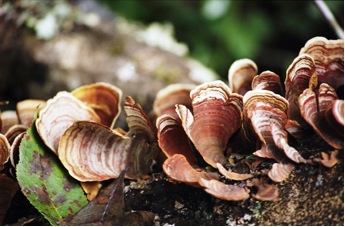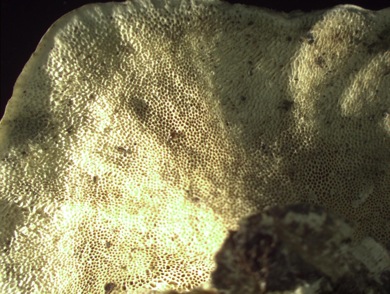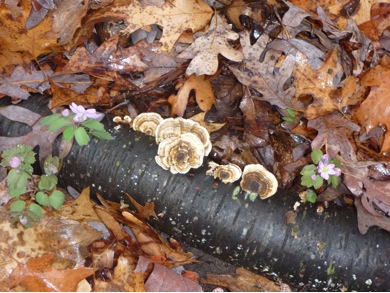Turkey Tail Fungus
Contact
Katharine Ordway Natural History Study Area9550 Inver Grove Trail Inver Grove Heights, MN 55076 651-455-6204 (On Site)
651-696-6230 (On Campus)
andersonm@macalester.edu
Biotic Inventory: Documenting Diversity at the Katharine Ordway Natural History Study Area
Trametes versicolor, the Turkey Tail fungus

Taxonomy
Kingdom Fungi
Division Basidomycota
Class Hymenomycetes
Order Aphyllophorales
Family Polyporaceae
Genus Trametes
Species versicolor
Common names: the Turkey Tail fungus or the Turkey Tail, Cloud mushroom, PSK, PSP, yun zhi,
Former names: Coriolus versicolor, and Polyporus versicolor
Diagnostic Characteristics
Fungi can generally be identified based on the length or presence of a stalk, the shape, size and color of their cup, and the traits of their gills or pores. In the case of the Turkey Tail fungus, there is no stalk present, only a cup that attaches directly to the tree or log on which it lives. The cup is concave in shape and up to 4 inches wide. In the case of my specimen the conk (the visible fanned part, it would be called a mushroom in a fungus with gills) was approximately 2 inches in diameter. It has a series of multicolored stripes across the conk ranging from white, to brown, to red to purple, although the specimens that I found were primarily brown and white. The darker stripes on a Turkey Tail are covered in very small hairs that can be seen clearly with a dissecting microscope, these hairy sections can help separate the Turkey Tail from similar fungi. Its texture is also very tough and leathery compared with many other fungi which have more delicate skins. The Turkey Tail fungus does not have gills, but rather pores, which sets it apart from many other common fungi. The pores can be seen very clearly through a dissecting microscope.
The family that the Turkey Tail belongs to, the polypores, all have these tiny structures on the underside of their . Each of these pores holds spores that the fungus uses for reproduction much like the gills that are found in most other mushrooms. These pores are an excellent way to tell the difference between Trametes versicolor and Stereum ostrea, the False Turkey Tail fungus.

In this picture taken with a camera mounted to a dissecting microscope the many tiny pores found on the underside of the Turkey Tail’s conk can be seen.
Ecology
The Turkey Tail fungus is a very common mushroom in North American woods, generally found on fallen logs or tree stumps year round, although they can also be found on living trees. They can live on over 70 different genera of hardwood trees and several conifers in the United States. Organisms that obtain nutrients from decomposing matter, like the Trametes versicolor are called saprotrophic organisms. More precisely, the Turkey Tail fungus breaks down the dead wood of a tree, using it as nutrients for itself while helping clear the forest for new growth. Because Turkey Tails consume the lignin in wood faster than the cellulose, they are said to create white rot, which tends to be white and stringy. An organism that degrades cellulose more quickly creates red rot.
The Turkey Tail specimen that I collected came off of a fallen birch tree lying on the forest floor in Macalester College’s Katharine Ordway Natural History Study Area.
Life History
The life cycle of a polypore fungus, like Trametes versicolor, begins when the haploid spores are blown by the wind away from the pores. These spores hopefully land in an area with favorable conditions and begin to grow. This haploid spore grows in to a germling, hopefully in close proximity to another germling. The two young fungi fuse their hyphae and mix their cell contents in a stage of the life cycle that is called plasmogamy. Each of the cells within each of the original germlings should now contain two different nuclei that are unfused, the fungus stays in this dikaryotic state for most of its life. As the fungus develops, it will eventually produce a fruitbody, which is the conk of the polypore fungus. The underside of the conk holds the pore surface, which is covered in tiny tubes (There are 2 to 5 tubes per millimeter on a Turkey Tail fungus) lined with basidia. Basidia are cells that carry out karyogamy or the fusion of the nuclei in the fungus’ dikaryotic cells, meiosis, which is the splitting of these diploid cells in to four haploid cells, and finally the production of spores. Spores are simply haploid cells produced through meiosis that have a coating that will allow them to germinate when they land on an appropriate surface. Spores that are produced by basidia are called basidiospores. After they are produced they are pushed out of the basidia and carried by the wind to begin the cycle again.
Distribution
The Turkey Tail fungus is often listed as being one of the most common fungi in North American woods. One website even says, “If you cannot find these you may need to consider visiting an eye doctor or giving up mushroom collecting.” (Spahr) These fungi grow in wet, shady areas in temperate forests in Asia, North America and Europe and are quite common across all three continents.
Voucher Information
The specimen was collected off of a birch branch on the floor of an oak woodland at the Katharine Ordway Natural History Study Area in Inver Grove Heights Minnesota. The branch was surrounded by leaf litter and many of the small purple flowers that can be seen in the photograph. The ground was wet due to recent rain, and the log was soaked through with water and almost spongy in texture.

References
Kuo, Michael. MushroomExpert.Com. “Trametes versicolor: The Turkey Tail.” <http://www.mushroomexpert.com/trametes_versicolor.html>
Lincoff, Gary H. National Audubon Society Field Guide to North American Mushrooms. National Audubon Society. Alfred A. Knopf. 1981.
Spahr, David. Mushroom-Collecting.com. 2009 <http://mushroom- collecting.com/mushroomturkey.html>
Volk, Thomas J. TomVolkFungi.net. “Tom Volk’s Fungus of the Month for August 1997.” 1997 <http://botit.botany.wisc.edu/toms_fungi/aug97.html>
Compiled by Anna Hardin.
Biodiversity & Evolution (BIOL 270) Professr Sarah Boyer. Spring 2010
Specimen collected at Macalester College’s Katharine Ordway Natural History Study Area on April 15, 2010.